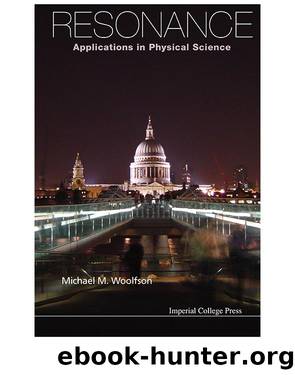Resonance Applications In Physical Science by Michael Mark Woolfson

Author:Michael Mark Woolfson
Language: eng
Format: epub
Publisher: Imperial College Press
Figure 6.1 The structure of sodium chloride. Large circle = sodium, small circle = chlorine.
The lesson drawn from these examples is that in most cases, when molecules form, subshells are filled and, since subshells always contain even numbers of electrons, there will always be a pairing of spin-up and spin-down electrons. Hence, for the most part, molecules have no net electron-spin angular momentum and are not amenable to examination by the technique of electron spin resonance (ESR) spectroscopy, which is analogous to the use of NMR technique described in Chapter 5. An exception would be for a class of molecules containing elements such as scandium, described in Section 6.1.1, where, although it may fill up an outer subshell in forming a molecule, still has an unpaired electron in an inner shell.
Exercise 6.2 Draw a diagram, similar to Figure 6.2, to represent the electronic structure of ammonia, NH3.
Download
This site does not store any files on its server. We only index and link to content provided by other sites. Please contact the content providers to delete copyright contents if any and email us, we'll remove relevant links or contents immediately.
Alchemy and Alchemists by C. J. S. Thompson(3303)
The Elements by Theodore Gray(2858)
The Club by A.L. Brooks(2758)
How to Make Your Own Soap by Sally Hornsey(2748)
Drugs Unlimited by Mike Power(2490)
Wheels of Life by Anodea Judith(1923)
Cracking the Sat French Subject Test, 2013-2014 Edition by The Princeton Review(1772)
Perfume by Jean-Claude Ellena(1742)
The Flavor Matrix by James Briscione(1718)
Cracking the LSAT, 2012 Edition by Princeton Review(1698)
The Cosmic Machine: The Science That Runs Our Universe and the Story Behind It by Scott Bembenek(1694)
MCAT Physics and Math Review by Princeton Review(1571)
1000 Multiple-Choice Questions in Organic Chemistry by Organic Chemistry Academy(1570)
The Thing Around Your Neck by Chimamanda Ngozi Adichie(1491)
Handbook of Modern Sensors by Jacob Fraden(1482)
Cracking the SAT Premium Edition with 6 Practice Tests, 2017 by Princeton Review(1481)
Synchrotron Light Sources and Free-Electron Lasers by Eberhard J. Jaeschke Shaukat Khan Jochen R. Schneider & Jerome B. Hastings(1461)
A is for Arsenic: The Poisons of Agatha Christie (Bloomsbury Sigma) by Kathryn Harkup(1458)
Harry Potter All Books: 8 Books by J.k.rowling(1438)
